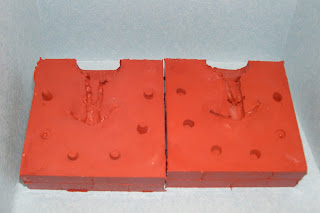My tips would be:
1. Think about safety, you're dealing with hot metal at 200-300 degrees, so be careful (eye protection, clamp or vice for mould etc)!
2. The mould won't work well when cold, the metal cools too quickly and you don't get the detail, some people heat the mould up first in an Oven, I haven't tried this (as I don't think my wife and kids would like it!) so can't vouch for its effectiveness. I just accept that the first few casts won't come out well, and effectively use them to get the mould up to temperature.
3. Metal temperature is critical, too cold and the detail won't cast, too hot and you get "pitting" which will give a rough surface on the figure. Its largely a case of trial and error to get it correct, my tip would be stick a matchstick in the metal for about a second, if it comes out smouldering and a bit charred, you're in the right area.
4. Talc dusted in the mould is essential, prior to casting. I just use cheap un-perfumed stuff from the supermarket and it works fine, sprinkle it over, blow off the excess and away you go. One dusting will last for a number of casts.
5. Once you get the correct temperature etc and the mould is casting well, stick with it, as its likely that each cast after this point will be successful.
So how did we get on with our mould, well....... mixed results, I did get it casting effectively, and got about a dozen or so usable casts out, the mould has however started to break up a bit in the area around the legs/ turnbacks as expected, its not critical, as its not an area where I'm losing detail, just means the figures require a bit more cleaning up.
In normal terms this is a pretty poor performance for a mould of this type, I have several that have happily cast 100+ times and are still ok. However as I highlighted a little while back, this figure did have "problems" and as such I'm happy that the mould has served its purpose and for the time being I have sufficient castings to create final masters. If I need more I'll consider making another mould.
Recognising this defect in the design, I'll be "beefing up" this section of the figure to try to eliminate this issue for the future. As I said in an earlier post, the sculpt has to be a compromise to some extent between realism and practicality of casting etc. In this case I've danced a little to close to the realism side and will need to step back a little to get a more robust end product.

Anyway here's a shot of three of the casts cleaned up and ready to be made into final masters. I've also now completed the mould for the weapons and am currently working on the mould for the heads. These should be ready soon, I will then cast up some weapons and heads, and we can then press on to actually make some completed masters.
Back once I've cast these bits...............



























